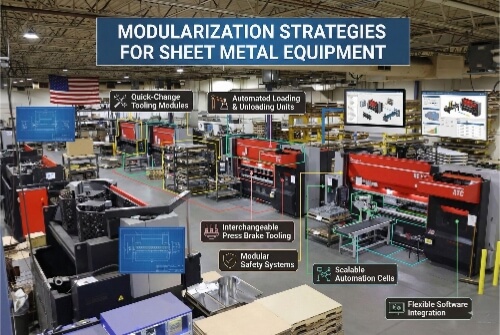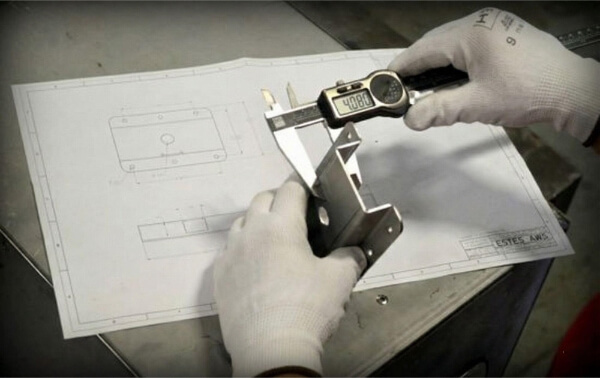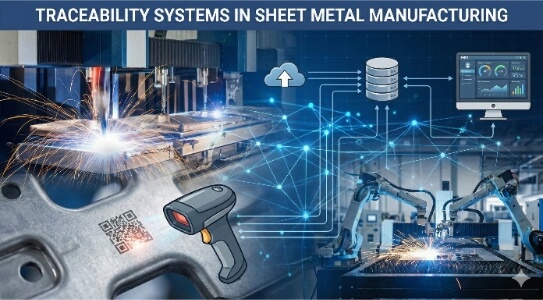En la fabricación de metales, el corte y el plegado suelen acaparar toda la atención. Pero lo que realmente da forma a la resistencia y el aspecto de una pieza viene después de esos pasos: el acabado. Un tratamiento superficial adecuado puede transformar una pieza normal en otra que resista la oxidación, el desgaste y los efectos de años de uso. Sin él, incluso los componentes bien fabricados pueden fallar prematuramente.
El acabado y el revestimiento de chapas metálicas protegen las piezas de entornos agresivos. Aumentan el rendimiento, mejoran el aspecto y mantienen la fiabilidad de las piezas a lo largo del tiempo. Tanto si diseña piezas como si adquiere componentes o gestiona la producción, la selección del acabado adecuado puede influir significativamente en la durabilidad y la calidad.
En este artículo se examinan varios métodos estándar de acabado y revestimiento, como el revestimiento en polvo, el anodizado, la galvanoplastia y la pasivación. Cada método tiene sus propias ventajas. Si sabe cómo afectan los distintos acabados a la solidez, la resistencia a la corrosión y el aspecto, podrá tomar decisiones más informadas que mejoren el rendimiento y la vida útil de su producto.
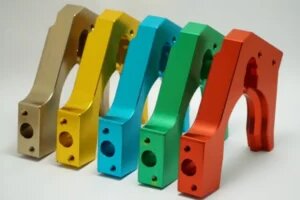
¿Qué es el acabado de chapa?
El acabado de chapas metálicas es la fase final de la fabricación que mejora el aspecto, la resistencia y el rendimiento de una pieza. Utiliza métodos mecánicos, químicos o electroquímicos para tratar la superficie metálica. Estos procesos eliminan pequeños defectos, alisan zonas rugosas y preparan las piezas para recubrimientos o pintura. El acabado también añade una capa protectora que ayuda a evitar la oxidación, la corrosión y el desgaste de la superficie.
Un buen acabado puede convertir el metal desnudo en una pieza lista para un uso prolongado. Puede detener la oxidación en condiciones húmedas o al aire libre y reducir la fricción entre las piezas móviles. Los acabados también facilitan la limpieza de las piezas y ayudan a mantener su aspecto durante más tiempo.
Tipos comunes de acabado de chapa metálica
Cada método de acabado tiene sus propias ventajas según la función de la pieza y el entorno de trabajo. A continuación se indican algunos de los acabados más populares y eficaces utilizados para piezas de chapa metálica.
Granallado
Granallado utiliza delicadas perlas de vidrio y aire comprimido para limpiar y alisar superficies metálicas. Este proceso elimina la herrumbre, la oxidación y las marcas de mecanizado, al tiempo que mantiene las dimensiones exactas de la pieza. Crea una superficie mate o satinada con una rugosidad de alrededor de Ra 1,0-3,0 μm, lo que la convierte en una base adecuada para su posterior recubrimiento o pintura.
Suele utilizarse en acero inoxidable, aluminio y acero dulce. El granallado mejora la adherencia del revestimiento y proporciona a las piezas un aspecto limpio y uniforme que oculta las pequeñas imperfecciones de la superficie. Es una opción excelente cuando se requiere un aspecto uniforme y una textura fina.
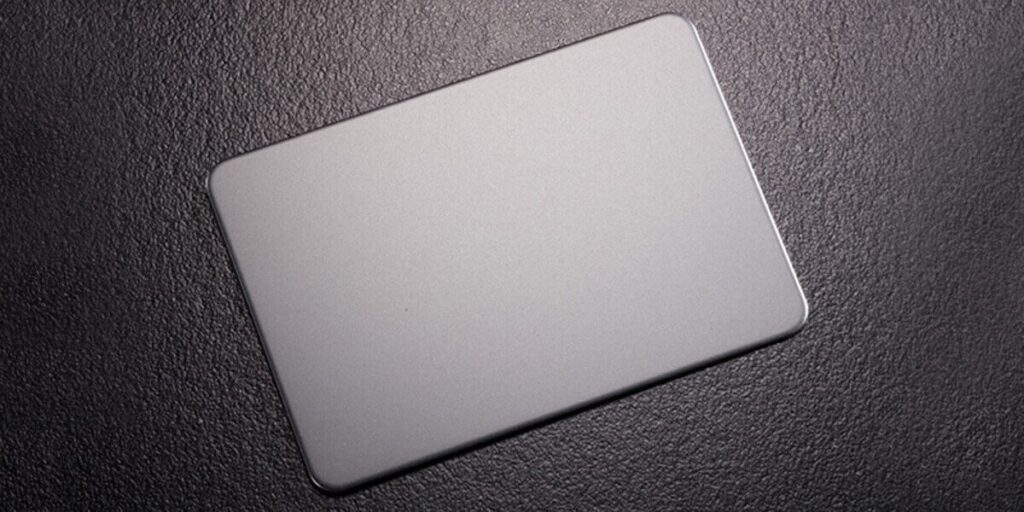
Recubrimiento en polvo
Recubrimiento en polvo consiste en pulverizar partículas de polvo cargadas sobre una superficie metálica conectada a tierra y, a continuación, curarlas en un horno a 180-200 °C. El polvo fundido forma una película continua y duradera de entre 60 y 120 μm de grosor.
Este revestimiento ofrece una excelente protección contra la corrosión, los impactos y los daños causados por los rayos UV, por lo que es adecuado tanto para aplicaciones interiores como exteriores. Las piezas con recubrimiento en polvo mantienen su color y brillo durante años, con una decoloración o descascarillado mínimos. Con innumerables colores y texturas entre los que elegir, este acabado se utiliza ampliamente para cerramientos, muebles y piezas de maquinaria que necesitan tanto resistencia como atractivo visual.
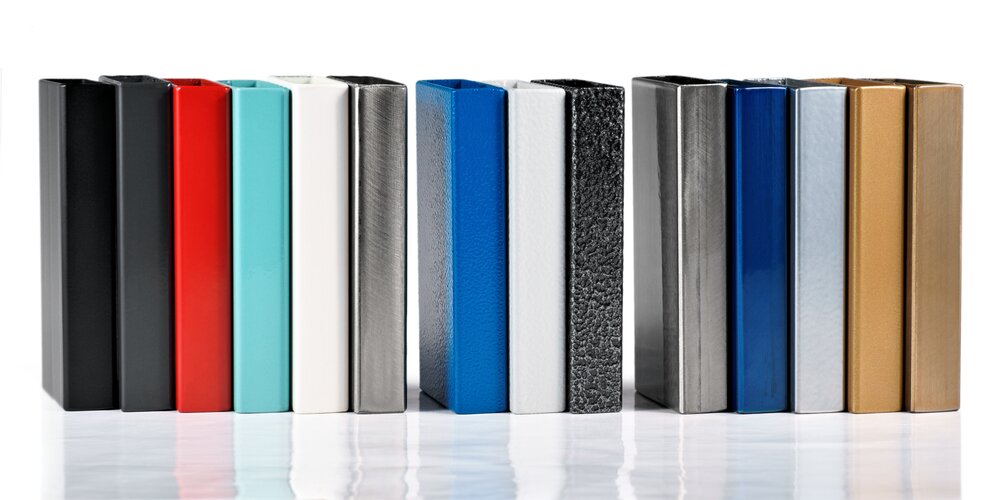
Pintura
Pintura añade una fina capa de 30-50 μm de revestimiento líquido para proteger el metal y darle color. La superficie se limpia y a veces se trata con una capa de fosfato para mejorar la adherencia de la pintura. A continuación, las piezas se hornean a 120-150°C para curar la pintura y aumentar su durabilidad.
Cada pintura se utiliza para un fin distinto:
- Pintura epoxi ofrece una gran resistencia química y es muy adecuado para máquinas industriales.
- Pintura acrílica seca rápido y funciona bien para muebles de interior o expositores.
- Pintura de poliuretano resiste la luz del sol y la lluvia, por lo que es ideal para aplicaciones en exteriores.
La pintura es flexible en cuanto a opciones de color y acabado, y rentable para prototipos o lotes pequeños. Aunque no es tan resistente como el recubrimiento en polvo, proporciona una superficie atractiva y fácil de limpiar con una sólida protección contra la intemperie.
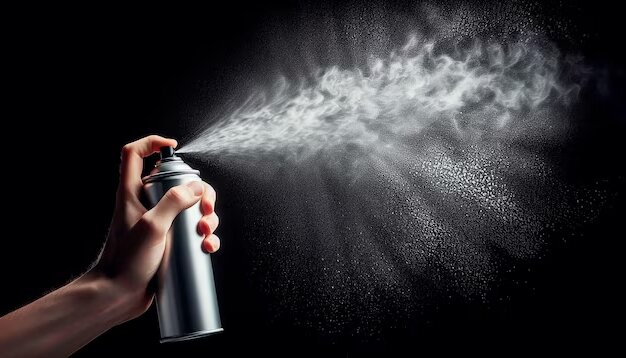
Galvanoplastia
Galvanoplastia utiliza una corriente eléctrica para recubrir una pieza con una fina capa de otro metal, como zinc, níquel o cromo. El revestimiento suele tener un grosor de 2-25 μm.
- Galvanizado proporciona resistencia a la corrosión y un aspecto plateado brillante.
- Niquelado añade dureza y resistencia al desgaste.
- cromado proporciona un acabado de espejo de gran durabilidad.
Las piezas galvanizadas se utilizan habitualmente en productos de automoción, electrónicos y decorativos, en los que tanto el aspecto como las prestaciones son esenciales.
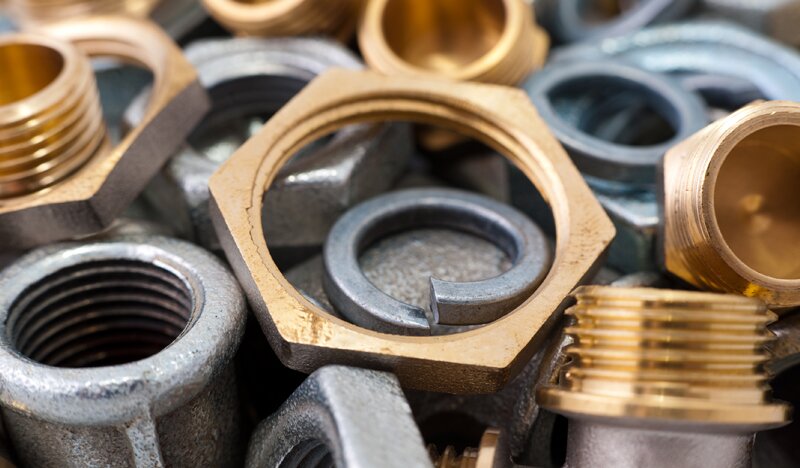
Anodizado
Anodizado se utiliza principalmente en aluminio para mejorar la resistencia a la corrosión y la dureza superficial. La pieza de aluminio se coloca en un baño de ácido, y una corriente eléctrica forma una capa de óxido fuertemente adherida de 10-100 μm de grosor.
El aluminio anodizado puede teñirse de varios colores. Como el tinte se absorbe en la capa de óxido, no se desconcha ni se descascarilla. Después, la superficie se sella con agua caliente para cerrar los poros y fijar el color.
- Anodizado tipo II (ácido sulfúrico) es común para uso del consumidor y arquitectónico.
- Anodizado tipo IIItambién conocido como anodizado duro, crea una capa más gruesa y dura para piezas aeroespaciales e industriales.
Las piezas anodizadas también ofrecen un fuerte aislamiento eléctrico, por lo que son adecuadas para carcasas, disipadores de calor y componentes electrónicos.

Pasivado y película química
El pasivado mejora la resistencia a la corrosión del acero inoxidable eliminando el hierro libre y las impurezas de la superficie. Forma una película de óxido fina e invisible sin cambiar el aspecto de la pieza.
En el caso del aluminio, un revestimiento de película química, como la conversión al cromato, proporciona una protección similar. Estos revestimientos son frágiles, suelen medir menos de un μm, y mantienen la conductividad eléctrica al tiempo que resisten la oxidación. Ambos tratamientos se utilizan habitualmente en cajas y conjuntos eléctricos en los que la conductividad y la resistencia a la corrosión son esenciales.
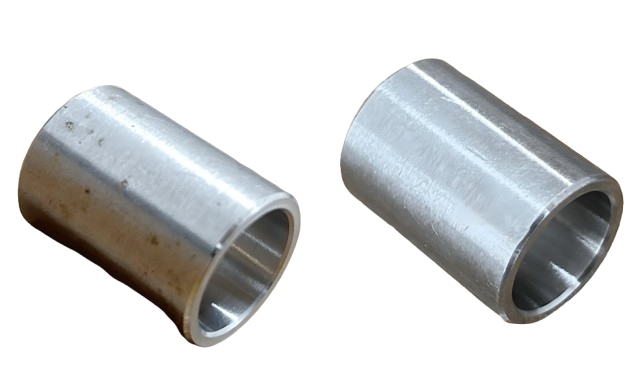
Recubrimiento electrónico
Recubrimiento E, también conocido como recubrimiento electroforéticoaplica la pintura uniformemente mediante un campo eléctrico. La pieza se sumerge en un baño de pintura a base de agua, se carga y se hornea a 160-190°C. El revestimiento final suele tener un grosor de 20-35 μm y cubre incluso formas complejas y esquinas estrechas.
El e-coating ofrece acabados lisos y brillantes con una excelente resistencia a la corrosión. Se utiliza mucho en la producción de automóviles y electrodomésticos porque ofrece una cobertura uniforme, una fuerte adherencia y resistencia al desconchado y la decoloración.
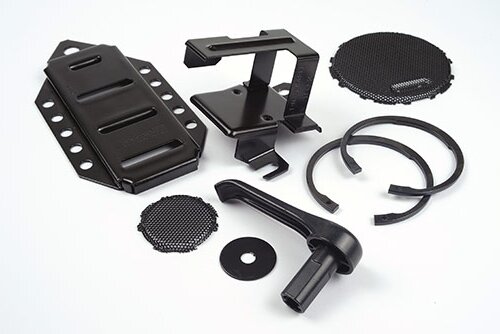
Ennegrecimiento en caliente
Ennegrecimiento en caliente, también llamado revestimiento de óxido negroforma una fina capa negra sobre el acero o el hierro. Las piezas se sumergen en una serie de baños químicos calientes que crean una capa de óxido de aproximadamente 1 μm de grosor.
Este acabado proporciona una ligera protección contra la corrosión, reduce los reflejos y da un aspecto oscuro uniforme. Se suele utilizar para herramientas, elementos de fijación y piezas de precisión que requieren un aspecto limpio y profesional, manteniendo al mismo tiempo unas dimensiones ajustadas.
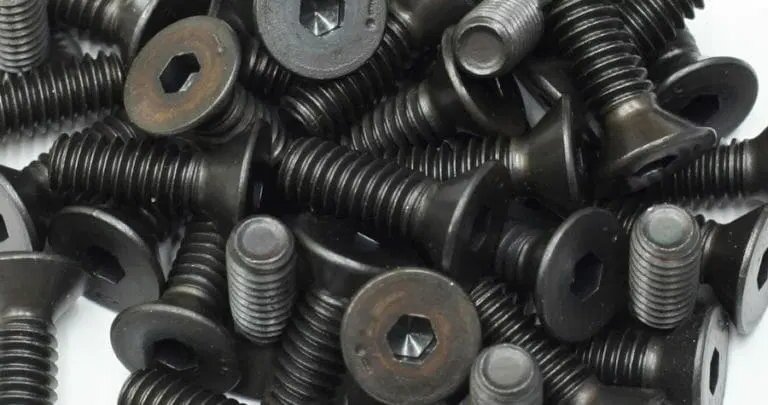
Cómo mejora el rendimiento el acabado de chapas metálicas?
Acabado de superficies no sólo da un buen aspecto a las piezas, sino que influye directamente en su rendimiento y duración. Cada tipo de tratamiento superficial desempeña un papel crucial en la protección de la pieza y la minimización de los costes a largo plazo.
Resistencia a la corrosión y al desgaste
Las piezas metálicas se enfrentan a menudo a condiciones adversas, como la humedad, los productos químicos o la fricción. Sin un acabado adecuado, estos factores pueden causar herrumbre, oxidación o desgaste de la superficie. Los acabados como el recubrimiento en polvo, el anodizado y la galvanoplastia crean una capa protectora que evita estos problemas. Por ejemplo, una caja de acero con recubrimiento en polvo puede resistir a la intemperie durante años, mientras que el aluminio anodizado se mantiene estable en entornos húmedos o marinos.
Los acabados también protegen contra el desgaste mecánico por contacto o movimiento repetidos. El anodizado duro y el niquelado hacen que las superficies sean más complicadas y resistentes a los arañazos o la abrasión. Al reducir la corrosión y el desgaste, el acabado superficial ayuda a prolongar la vida útil de la pieza y reduce los costes de mantenimiento, una ventaja clave tanto en la producción como en el uso diario.
Ventajas estéticas y de marca
Un acabado de calidad confiere al producto un aspecto profesional y de gran valor. Los recubrimientos lisos y uniformes ayudan a que las piezas parezcan precisas y duraderas, lo que refuerza la confianza del cliente en la marca. Los acabados, como el recubrimiento en polvo y la pintura, se presentan en una amplia gama de colores y texturas, lo que proporciona a las empresas la flexibilidad necesaria para adaptarse a sus objetivos de marca y diseño.
En los productos de consumo, el aspecto y el tacto son tan importantes como la función. Una superficie satinada o un recubrimiento en polvo brillante transmiten calidad y atención al detalle. Además de la apariencia, los acabados también evitan la decoloración, lo que ayuda a que los productos mantengan su aspecto limpio con el paso del tiempo.
Rendimiento eléctrico y térmico
Algunos acabados mejoran la capacidad de una pieza para soportar la electricidad o el calor. La galvanoplastia de níquel o cobre mejora la conductividad eléctrica, por lo que es ideal para terminales, conectores y componentes electrónicos. Por otro lado, el aluminio anodizado aísla las piezas que deben bloquear el flujo de corriente, como las carcasas o los disipadores térmicos.
Los acabados también pueden mejorar la transferencia de calor. Los revestimientos protectores que reducen la oxidación mantienen un rendimiento térmico estable, especialmente en componentes como fuentes de alimentación o módulos LED. Seleccionar el acabado adecuado en función de las necesidades eléctricas o térmicas garantiza que la pieza funcione con seguridad y eficacia en condiciones reales.
¿Cómo elegir el acabado de chapa adecuado?
Cada pieza tiene unas necesidades de rendimiento diferentes, y el mejor acabado depende de dónde y cómo se vaya a utilizar. La elección correcta mejora tanto la función como el aspecto. Estos son los principales puntos que hay que tener en cuenta al seleccionar un acabado.
¿Cómo se adapta el acabado al material?
Los distintos metales responden de forma diferente a los métodos de acabado. El material de base determina qué tratamientos se adherirán bien y proporcionarán una protección duradera.
El aluminio funciona mejor con anodizado, que mejora la dureza y ofrece una gama de opciones de color. También combina bien con el recubrimiento en polvo o la pintura cuando se necesita una mayor resistencia a la corrosión o decoración.
El acero inoxidable se beneficia más de la pasivación y el granallado, que limpian y protegen sin reducir su resistencia natural a la corrosión. Para un aspecto más oscuro o brillante, puede utilizarse el recubrimiento E o el electropulido.
El acero dulce necesita una mayor protección, ya que se oxida con facilidad. El cincado, el recubrimiento en polvo y la pintura son opciones habituales para formar una barrera sólida contra la humedad y la oxidación.
El cobre y el latón suelen utilizarse con revestimientos transparentes o niquelados para evitar que se empañen y mantener su color metálico. Dado que cada metal reacciona de forma diferente a su entorno, la selección de un acabado compatible garantiza tanto un rendimiento duradero como un aspecto atractivo.
| Acabado | Acero carbono | Acero inoxidable | Aluminio | Aleaciones de cobre | Acero galvanizado |
|---|---|---|---|---|---|
| Óxido negro | Adecuado para herramientas, accesorios y elementos de fijación; añade una ligera resistencia a la corrosión. | No se suele utilizar. | No apto. | No apto. | No apto. |
| Galvanoplastia | Se utiliza en revestimientos de zinc, níquel o cromo para mejorar el aspecto y la protección contra la corrosión. | Normalmente innecesario debido a la resistencia natural a la corrosión. | No se utiliza habitualmente. | A menudo se utiliza para acabados decorativos o protectores de níquel y cromo. | No se recomienda. |
| Anodizado | No apto. | No apto. | Común para piezas de aluminio; mejora la resistencia al desgaste y la estabilidad del color. | No apto. | No apto. |
| Pintura | Acabado común de bajo coste; añade protección contra la corrosión y la intemperie. | Funciona como una capa de barrera adicional; colores personalizables. | Acabado flexible para prototipos y productos de consumo. | Proporciona resistencia al color y al deslustre. | A menudo se utiliza para piezas exteriores que necesitan uniformidad visual. |
| Recubrimiento en polvo | Proporciona un revestimiento duradero y resistente a los impactos; se utiliza para maquinaria y piezas de exterior. | Ideal para aplicaciones industriales que requieren tanto durabilidad como estética. | Acabado decorativo popular con fuerte protección contra la corrosión. | Se aplica para una protección duradera del color. | Aumenta la resistencia a la corrosión en piezas previamente recubiertas. |
| Pasivación | No se aplica. | Mejora la resistencia a la corrosión y la estabilidad de la superficie. | No apto. | No apto. | No apto. |
| Pulido | Aumenta la suavidad de la superficie y mejora el aspecto. | Acabado espejo o cepillado. | Mejora la reflectividad y la suavidad. | Se utiliza para realzar la decoración. | Mejora el aspecto y la limpieza de la superficie. |
| Chorro de arena | Limpia la oxidación y prepara las superficies para el revestimiento. | Elimina las incrustaciones y mejora la adherencia a la superficie. | Crea una textura mate uniforme. | Se utiliza para limpiar y texturizar antes del acabado. | Prepara la superficie para la pintura o el recubrimiento en polvo. |
¿Cuál es el entorno operativo de la pieza?
El entorno tiene un impacto significativo en la vida útil de un pez. Las piezas utilizadas en entornos húmedos, salinos o químicamente ricos requieren una alta resistencia a la corrosión. El revestimiento en polvo y el anodizado son adecuados para aplicaciones en exteriores o cerca del agua. Para aplicaciones interiores, la galvanoplastia o la pasivación suelen proporcionar protección suficiente.
Cuando las piezas estén expuestas al calor, la fricción o el contacto con otros componentes, seleccione acabados que puedan soportar el desgaste mecánico. Para equipos médicos o alimentarios, lo ideal son acabados lisos y fáciles de limpiar, como el acero inoxidable pulido o el aluminio anodizado.
¿Cuáles son sus necesidades de rendimiento?
Cada acabado ofrece distintas ventajas mecánicas y funcionales. Para la resistencia a la abrasión, utilice el anodizado duro o el niquelado. Para la conductividad eléctrica, elige el zincado o el recubrimiento de película química, que mantiene un buen contacto entre las superficies metálicas.
Si su objetivo es la consistencia visual, el recubrimiento electrolítico y el recubrimiento en polvo proporcionan un color y un brillo uniformes. Las piezas móviles se benefician de superficies más lisas que reducen la fricción y evitan el desgaste prematuro. Adaptar el acabado a la finalidad de la pieza ayuda a mantener el rendimiento y la fiabilidad a lo largo del tiempo.
¿Cuáles son sus limitaciones presupuestarias y temporales?
El coste y los plazos suelen orientar las decisiones de acabado. La pintura en spray y el granallado son asequibles y rápidos, por lo que resultan adecuados para prototipos o series de producción a pequeña escala. El recubrimiento en polvo y el recubrimiento electrolítico requieren más tiempo de preparación, pero son más eficaces para la producción en serie.
Si el tiempo es limitado, elija acabados con tiempos de curado o secado cortos. Para ahorrar a largo plazo, invertir en acabados duraderos puede reducir los costes futuros de mantenimiento y sustitución.
¿Qué aspecto quieres conseguir?
El acabado de la superficie define el aspecto y el tacto del producto. Un acabado mate o cepillado aporta un estilo industrial, mientras que el cromado o el recubrimiento en polvo brillante crean un aspecto moderno y de alta gama.
El color, el brillo y la textura influyen en la forma en que los clientes perciben la calidad. Los diseñadores suelen elegir acabados que encajen con la imagen de su marca, al tiempo que buscan un equilibrio entre rendimiento y coste.
Capacidades de acabado y revestimiento de Shengen
En Shengen apoyamos los proyectos desde el prototipo hasta la producción. Ofrecemos un conjunto completo de servicios de acabado y revestimiento. Nos centramos en una calidad estable y unos plazos de entrega rápidos.
Llevamos a cabo varias opciones de acabado internas para mantener el control y la velocidad:
- Recubrimiento en polvo: Ofrecemos una gran variedad de texturas y niveles de brillo. El revestimiento se adhiere bien y dura a la intemperie. Se adapta a cerramientos, marcos y piezas estructurales.
- Cuadro: Igualamos los colores rápidamente para prototipos y pequeñas tiradas. El acabado tiene un aspecto suave y limpio.
- Granallado y chorreado de arena: Limpiamos y alisamos la superficie antes del revestimiento. La textura mate ayuda a que la pintura o el polvo se adhieran mejor.
- Pulido y cepillado: Mejoramos el aspecto, eliminamos arañazos finos y conseguimos un acabado satinado o de espejo.
También colaboramos con talleres de tratamiento de superficies de confianza para necesidades especiales:
- Anodizado (Tipos II y III): Mejoramos el aluminio con una mayor resistencia al desgaste y a la corrosión. Ofrecemos colores transparentes, negros y personalizados.
- Galvanoplastia: Añadimos zinc, níquel o cromo para proteger o mejorar el aspecto. También mejoramos la conductividad cuando es necesario.
- E-Coating: Proporcionamos una película lisa y uniforme sobre formas complejas. El resultado es de primera calidad y uniforme.
- Pasivación: Tratamos el acero inoxidable para mejorar su resistencia a la corrosión sin alterar su aspecto ni la textura de su superficie.
Puede enviarnos sus planos y especificaciones. Nuestro equipo revisará su material, examinará sus objetivos y evaluará su presupuesto. Prepararemos un presupuesto preciso con plazos de entrega y notas técnicas.
Nuestros ingenieros pueden ayudarle a comparar opciones. Podemos explicarle cuándo el recubrimiento en polvo supera al anodizado, así como cuándo otro acabado es más adecuado. Facilítenos los detalles de su pieza y le asesoraremos gratuitamente sobre el tratamiento superficial y el precio.
Preguntas frecuentes sobre el acabado de chapa metálica
A continuación encontrará respuestas a algunas preguntas habituales sobre el acabado y revestimiento de superficies de chapa metálica. Estos detalles pueden ayudarle a planificar su proceso de acabado con expectativas claras.
¿Puedo personalizar el color o la textura de mi acabado?
Sí. Ofrecemos personalización a todo color de acuerdo con las normas RAL o Pantone. El recubrimiento en polvo, la pintura y el anodizado permiten obtener una amplia gama de colores y texturas superficiales, desde acabados suaves y mates hasta brillantes. Para que la marca coincida, podemos realizar pruebas de muestra antes de la producción para confirmar la precisión y la coherencia del color.
¿Qué espesor suelen tener los revestimientos?
El grosor del revestimiento varía según el tipo de acabado y las necesidades funcionales:
- Recubrimiento en polvo: 60-120 μm
- Pintura en aerosol: 30-50 μm
- Anodizado: 10-100 μm (depende del tipo II o III)
- Galvanoplastia: 2-25 μm
- E-Coating: 20-35 μm
Nuestros técnicos comprueban el grosor del revestimiento durante toda la producción para garantizar una cobertura uniforme y una protección adecuada.
¿Cuál es el plazo de entrega habitual para el acabado?
El plazo de entrega depende del proceso y del tamaño del pedido. Los acabados sencillos, como el granallado o la pintura, suelen tardar entre 3 y 5 días en lotes pequeños. Los acabados más avanzados, como el anodizado o la galvanoplastia, pueden tardar entre 7 y 10 días, incluyendo la preparación de la superficie y la inspección. Las grandes series de producción se planifican para garantizar tanto una alta calidad como un plazo de entrega rápido.
¿Pueden retocarse o acabarse las piezas si es necesario?
Sí, en la mayoría de los casos. Los revestimientos como la pintura, el recubrimiento en polvo o el anodizado pueden eliminarse y volver a aplicarse. El proceso exacto depende del material y del tipo de acabado. Las piezas finas de aluminio, por ejemplo, requieren una manipulación cuidadosa para evitar daños. Antes del repaso, nuestro equipo inspecciona cada pieza para encontrar la solución más segura y rentable.
¿Ofrecen certificaciones o pruebas de calidad?
Sí. Todas las piezas acabadas se someten a inspecciones de adherencia, espesor y superficie antes de su envío. Si lo solicita, podemos proporcionarle certificados RoHS, resultados de pruebas de niebla salina e informes de dureza para cumplir los requisitos de calidad específicos de su proyecto.
Hola, soy Kevin Lee

Durante los últimos 10 años, he estado inmerso en diversas formas de fabricación de chapa metálica, compartiendo aquí ideas interesantes de mis experiencias en diversos talleres.
Póngase en contacto

Kevin Lee
Tengo más de diez años de experiencia profesional en la fabricación de chapas metálicas, especializada en corte por láser, plegado, soldadura y técnicas de tratamiento de superficies. Como Director Técnico de Shengen, me comprometo a resolver complejos retos de fabricación y a impulsar la innovación y la calidad en cada proyecto.

